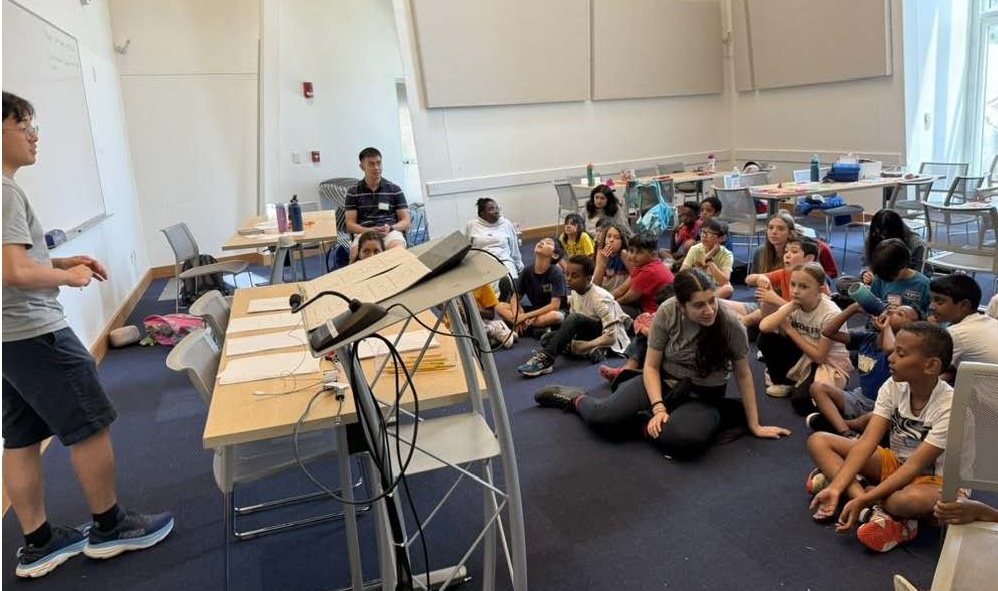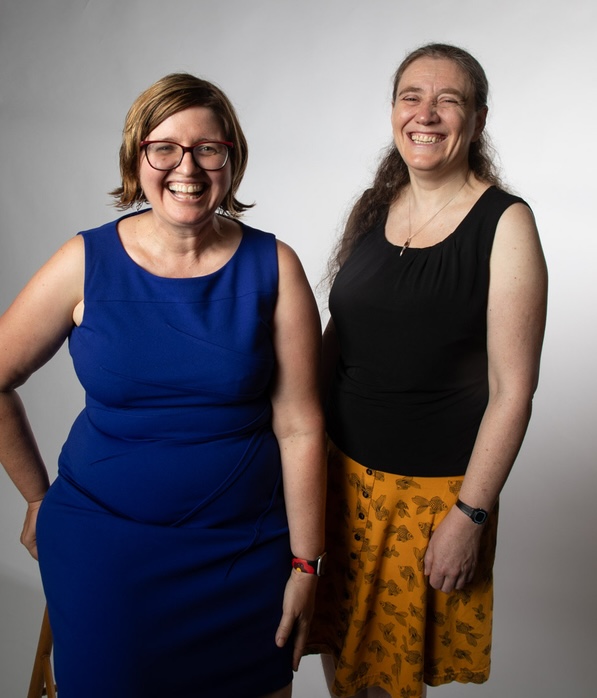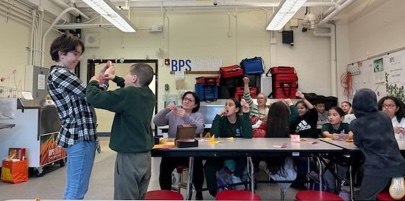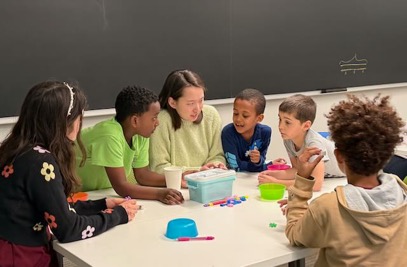Sharing the joy of math via the Cambridge Math Circle

By Sandi Miller
Members of the MIT Math community have been working directly with kids to share the joy of math discovery at the local nonprofit Cambridge Math Circle (CMC). This summer, Isabel McGuigan ’25 and graduate student Hamilton Wan led students through investigations of Boolean logic, logic gates, and Euler’s formula, among other topics, at CMC’s summer camps held at the Stata Center and Harvard.

CMC was founded in 2018 by MIT Math alum Nataliya Yufa ’01, along with Harvard Math PhD Mira Bernstein. The organization gathers undergraduate and graduate students as well as faculty from MIT and Harvard to expose local K-8 students to mathematical exploration and the joy of solving fun, challenging problems. Other past MIT Math community member participants include undergrads Sophia Benjamin and Elizabeth Li, grad students Serina Hu and Vijay Srinivasan, and professors Pavel Etingof, Ju-Lee Kim, and Paul Seidel.
As Hamilton’s advisor, Pavel introduced him to Nataliya in July. She responded by asking him to prepare a short interactive lesson related to topology.
“I had a blast working with the students at the summer camp,” says Hamilton. “They were excited, full of energy, and boundlessly curious. It certainly required a bit more energy than I expected, but was ultimately quite rewarding. They were very engaged with the lesson, asking me many questions even after we finished! It was also a lot of fun seeing them build all sorts of wild shapes and graphs.”
Isabel had just graduated and was looking for part-time work when she read about CMC on the math major mailing list. “Working with the students was fun,” says Isabel. “They were energetic and inquisitive, and it was delightful to get to watch them discover the math behind the games we played and the activities we did.”
Nataliya says that the CMC was the result of years of experience being a student and educator in math classrooms around the world. By figuring out her own learning styles, she became attuned to how to teach math to a diverse classroom.

“The experience of being a student in many different settings — in Ukraine, in different high schools in New York City, and at MIT, as well as teaching and visiting classrooms — taught me that some approaches work well for certain students, and others, for a greater subset.”
After graduating from MIT, Nataliya researched block copolymers for her PhD in physics from the University of Chicago and as a postdoc at the University of Cambridge. Her experience teaching on the South Side of Chicago gave her a glimpse into inequities in the K-12 education system, inspiring her to pursue math education as a career full-time.
She noted the differences in STEM education between the well-funded schools vs. the poorest communities.
“I saw kids who couldn’t figure out what 3 times 3 was for a science experiment in one school,” recalled Nataliya. “To study flight, students build airplanes. At the poor kids’ school, the planes they built looked like planes, but they could never glide, let alone fly. The materials they had were paper towel rolls and scissors. At the wealthy school, the kids were armed with sufficient knowledge, equipment, and materials to make hovercraft that could support the weight of a child. That’s when I realized I wanted to do something about this inequality,” said Nataliya.
After leaving physics research behind, Nataliya first became an education researcher, which eventually led her into the classroom. While teaching math at an independent school in Boston, Nataliya met Mira Bernstein, a math researcher and an educator with over 20 years of experience. Mira helped Nataliya set up a nonprofit math circle in Cambridge, starting with about 20 second-graders.
In 2019, Paul Seidel’s kids participated in CMC, one as a student, the other as a volunteer. He decided to do some guest teaching, showing kids how intransitive dice work. More MIT Math community members soon followed.

This summer, the camp served 150 students. During the school year, about 400 students participate each week, either at their schools, on Saturdays at Harvard, or online. There are 40 to 50 instructors at any given time, both paid and volunteer.
Nataliya says that part of CMC’s success is because she counts herself among those students who struggle to connect with material presented in the traditional lecture format.
“Many students did much better when there were regular breaks for us to ask and answer questions that checked our understanding, allowed us to see how the material connected both to things we’ve learned previously and things we would be learning in the future, and involved talking with and working with peers,” she says.
For example, as an undergraduate at MIT, her undergraduate research project in knot theory with Prof. Tomasz Mrowka “was a lot more appealing to me once I learned that it was not just theoretical, but that a lot of it applied to molecular medicine as well.”

“Over time, teaching in different settings, from highly respected universities to struggling schools, I saw that certain principles applied everywhere. Virtually all students became more engaged when they learned how a certain concept is useful in everyday life, or when the problems had fun elements, like their favorite teaching instructors, movies, or foods being part of the problem.”
“It helped bring down the anxiety that naturally arises when solving hard problems and allowed students to use all of their brainpower on solving the problems, rather than concentrating on worrying about not being able to solve them,” she says.
She also finds that adding small details, such as writing the lesson’s goals and timeline on the board, helps students feel more in charge of their learning. “They could see where we were going and ask questions about it, and they knew what to expect,” she says. “And while these and countless other adjustments work well for virtually all students, they are especially powerful for those who think more deeply and slowly, which in my experience often includes girls.”
She also wants to create a path for students from a variety of backgrounds to pursue STEM careers and attend institutions like MIT and Harvard.
“As a parent of a girl who loved math from a young age, I wanted to make sure that she and her friends and classmates kept that love and curiosity, and that was one of my inspirations for co-founding CMC,” says Nataliya.

CMC students learn to think like a mathematician, scientist, or engineer, exploring college-level areas of math such as combinatorics, graph theory, logic, and topology. CMC’s goal is to build students’ confidence in STEM, to help prepare them for challenging math classes in high school and college, and, ultimately, to pursue STEM-related careers.
The program features a collaborative environment where all students experience complex mathematical concepts through games, puzzles, and building challenges. Students develop logic, creative problem-solving skills, and resilience when faced with challenging problems.
CMC leads classes online (Preparatory Math classes using Beast Academy and Art of Problem Solving), as well as in-person Math Circle classes at Harvard.
Families can register for classes by visiting the CMC Programs page. CMC also partners with several Cambridge Public Schools to offer after-school programming.
Note: This program isn’t related to MIT Math’s Menezes Challenge PRIMES Circle, which is a free after-school math enrichment program for talented high school students living within commuting distance from Boston.
